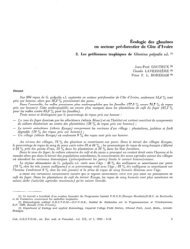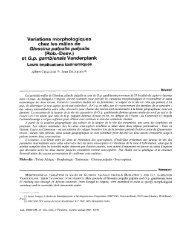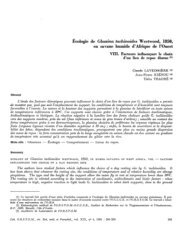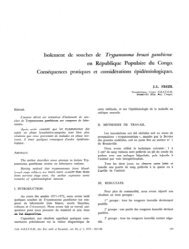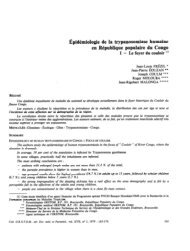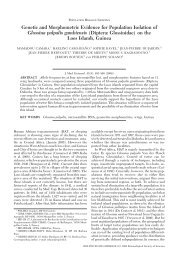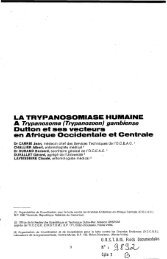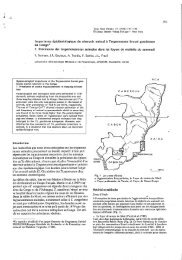Mixed populations of Trypanosoma brucei in wild Glossina palpalis ...
Mixed populations of Trypanosoma brucei in wild Glossina palpalis ...
Mixed populations of Trypanosoma brucei in wild Glossina palpalis ...
Create successful ePaper yourself
Turn your PDF publications into a flip-book with our unique Google optimized e-Paper software.
<strong>Mixed</strong> Populations <strong>of</strong> Z <strong>brucei</strong> <strong>in</strong> <strong>wild</strong> G. <strong>palpalis</strong> <strong>palpalis</strong> Trop. Med. Parasitol. 45 (1994)-<br />
315<br />
Controls, <strong>populations</strong> tested with the Z congolense<br />
(Savannah type) and I: simiae probes, were negative.<br />
Molecular karyotype analysis<br />
The three uncloned <strong>populations</strong>, GPAP/CI/<br />
89/KP 13, GPAP/CI/89/KP 14 and GPAP/CI/89/KP 33,<br />
had dist<strong>in</strong>ct karyotypes. However, only KP 33, which<br />
yielded two dist<strong>in</strong>ct karyotypes, produced clones with<br />
different chromosome band<strong>in</strong>g patterns (Fig. 1).<br />
Isoenzymes: zymodemes<br />
The isoenzyme band<strong>in</strong>g patterns obta<strong>in</strong>ed<br />
were coded accord<strong>in</strong>g to Mathieu-Daudé (1991) and Truc<br />
et al. (1991). Us<strong>in</strong>g the fifteen enzyme systems, <strong>in</strong>terpreted<br />
as 17 loci (see <strong>in</strong>terpretation), 17 zymodemes were<br />
recognised <strong>in</strong> the 35 <strong>populations</strong> analysed (Fig. 2), <strong>in</strong>clud<strong>in</strong>g<br />
the standard stocks. Sample <strong>populations</strong>, <strong>in</strong>clud<strong>in</strong>g<br />
parental stocks, were classified <strong>in</strong>' 15 zymodemes; cloned<br />
<strong>populations</strong> were classed <strong>in</strong> 14 zymodemes. Full details <strong>of</strong><br />
these isoenzyme data are available on request from J. R.<br />
Stevens.<br />
The follow<strong>in</strong>g seven loci were <strong>in</strong>variant<br />
and monomorphic for the 35 <strong>populations</strong> (<strong>in</strong>clud<strong>in</strong>g three<br />
standard <strong>populations</strong>) studied: GPI, MEA, NHIA, NHIB,<br />
NHD, TDH, MDH. Among the 32 sample <strong>populations</strong> an<br />
eighth enzyme, LAP, was also <strong>in</strong>variant and monomorphic.<br />
The parental population <strong>of</strong> KP 13 and all five cloned<br />
<strong>populations</strong> were enzymatically identical, and were<br />
placed <strong>in</strong> zymodeme 4. The n<strong>in</strong>e cloned <strong>populations</strong> <strong>of</strong> KP<br />
14 were classified <strong>in</strong> five zymodemes; the parental stock<br />
was classified <strong>in</strong> the same zymodeme (25) as two <strong>of</strong> it's<br />
cloned <strong>populations</strong>. The ffteen cloned popdations <strong>of</strong> KP<br />
33 were classified <strong>in</strong> n<strong>in</strong>e zymodemes, while the parental<br />
stock was placed <strong>in</strong> a separate zymodeme (210); one<br />
cloned population was placed <strong>in</strong> 24 with all <strong>populations</strong><br />
<strong>of</strong> KP 13.<br />
Due to the large number and selection <strong>of</strong><br />
enzyme systems exam<strong>in</strong>ed <strong>in</strong> the current study, the direct<br />
match<strong>in</strong>g <strong>of</strong> zymodemes with those described <strong>in</strong> previous<br />
studies (Godfrey et al., 1990; Stevens et al., 1992; Truc<br />
and Tibayrenc, 1993) was not possible. Indeed, as Tibayrenc<br />
and Ayala (1988) po<strong>in</strong>t out, del<strong>in</strong>eation <strong>of</strong> zymodemes<br />
is highly dependent upon the methods used,<br />
and upon the range <strong>of</strong> isoenzyme markers under study.<br />
This was particularly true for comparisons made with<br />
earlier studies which used th<strong>in</strong>-layer starch gel electrophoresis<br />
(Gibson et al., 1980; Letch, 1984; Tait et al.,<br />
1984).<br />
Isoenzymes: <strong>in</strong>terpretation<br />
For four <strong>of</strong> the fifteen enzyme systems, a<br />
genetic <strong>in</strong>terpretation <strong>of</strong> isoenzyme patterns was not<br />
possible; thus, the numerical analysis was phenetic. However,<br />
an allelic <strong>in</strong>terpretation <strong>of</strong> eleven enzymes, equat<strong>in</strong>g<br />
to thirteen loci, was possible, allow<strong>in</strong>g analysis to be<br />
based on a total <strong>of</strong> 17 putative loci. Such an <strong>in</strong>terpretation<br />
also permitted further <strong>in</strong>vestigation <strong>of</strong> the genetic relationships<br />
between <strong>populations</strong>.<br />
% SIXILARIW<br />
100 95 90 85 80 15<br />
Population z 1<br />
KP 33 cl. 5<br />
KP 33 c1.15<br />
KP 33 cl. 2<br />
KP 33 cl. 6<br />
KP 33 cl. 7<br />
KP 33 Cl. 4<br />
KP 33 c1.12<br />
KP 33 Cl. 1<br />
KP 33 cl. 8<br />
KP 14 cl. 2<br />
KP 14 cl. 3<br />
KP 14 cl. 1<br />
KP 33 c1.13<br />
KP 33 cl.14<br />
'KP 2<br />
KP 33 Cl. 9<br />
KP 33 Cl.10<br />
KP 14 cl. 7<br />
KP 14 cl. 8<br />
KP 14 cl. 4<br />
KP 14 cl. 6<br />
KP 14 cl. 9<br />
'BIYAMINA<br />
12<br />
14<br />
KP 14 cl. 5<br />
*TH 1<br />
KP 13 cl. 5<br />
KP 33 cl. 3<br />
KP 13 cl. 1<br />
KP 13 cl. 3<br />
KP 13 cl. 4<br />
KP 13 cl. 2<br />
KP 33 C1.16 17<br />
13<br />
16<br />
11<br />
15 I 1<br />
5<br />
6 1<br />
-<br />
P 1<br />
Fig. 2 Dendrogram constructed by UPGMA from a Jaccard similarity<br />
coefficient matrix. Cloned <strong>populations</strong> are shown, together with the<br />
three standard stocks (marked*) which equate to the recognised subspecies<br />
<strong>of</strong> 7: <strong>brucei</strong>; KP 2, 7: b. <strong>brucei</strong>; TH 1, 7: b. rhodesiense; BIY-<br />
AMINA, 7: b. gambiense; KP 2 and BlYAMlNA are also cloned stocks.<br />
The zymodeme (Z) <strong>in</strong>to which a population is classified is shown at<br />
the end <strong>of</strong> each branch.<br />
1 .<br />
Previous studies <strong>of</strong> enzyme polymorphisms<br />
<strong>in</strong> 7Yypanozoon show homozygous and heterozygous patterns<br />
typical <strong>of</strong> monomeric and dimeric enzymes <strong>in</strong> a<br />
diploid organism (Gibson et al., 198O;Tait, 1980; Stevens<br />
and Godfrey, 1992; Truc and Tibayrenc, 1993). Given that<br />
trypanosomes are diploid, practical allelic <strong>in</strong>terpretation<br />
<strong>of</strong> isoenzyme pattern followed the method described by<br />
Ferguson (1980) and Ben Abderrazak et al. (1993). S<strong>in</strong>gle<br />
band patterns were <strong>in</strong>terpreted as homozygotes for all<br />
enzymes. Double and triple band patterns were <strong>in</strong>terpreted<br />
as heterozygotes, associated with monomeric and<br />
dimeric enzymes respectively; alleles were allocated on<br />
the basis <strong>of</strong> the positions <strong>of</strong> the upper and lower bands <strong>in</strong><br />
a pattern. Only consistently reproducible bands were <strong>in</strong>cluded,<br />
and samples were rem electrophoretically to<br />
elucidate the validity <strong>of</strong> weak shadow bands and poorly<br />
separated multiple patterns.<br />
Genetic <strong>in</strong>terpretation <strong>of</strong> most isoenzymes<br />
was straightforward; however, ME and NHI produced two<br />
dist<strong>in</strong>ct sets <strong>of</strong> band patterns, not easily expla<strong>in</strong>ed as the<br />
product <strong>of</strong> a s<strong>in</strong>gle locus. Consequently, ME and NHI were<br />
<strong>in</strong>terpreted as two loci and the follow<strong>in</strong>g nomenclature<br />
was adopted: MEA, MEB and NHIA, NHIB.<br />
Numerical analysis<br />
The degree <strong>of</strong> genetic variation present<br />
with<strong>in</strong> the cloned <strong>populations</strong> from the three orig<strong>in</strong>al<br />
sample isolates is shown <strong>in</strong> the dendrogram (Fig.2); the<br />
high degree <strong>of</strong> variation present <strong>in</strong> two <strong>of</strong> the isolates<br />
(GPAP/CI/89/KP 14 and GPAP/CI/89/KP 33) is <strong>of</strong> particular<br />
note. However all <strong>populations</strong>, clones and standards,<br />
are greater than 78% similar, though such a result<br />
-<br />
-<br />
'<br />
J



